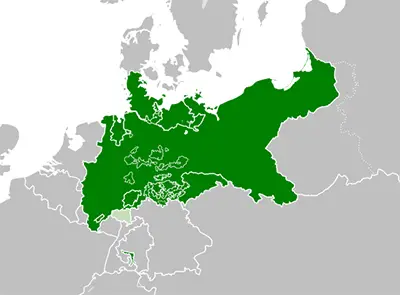The North German Confederation
The North German Confederation was a collection of German states formed under the umbrella of Prussian dominance in the latter half of the 19th Century. One such organization existed already, the German Confederation, formed in 1815 after the Congress of Vienna. That confederation included Austria and Prussia, both of whom ruled the roost. Those two powers actively suppressed liberal sentiments during the Revolutions of 1848. One outcome of the revolution in German lands was the formation of the Frankfurt Parliament, a representative body otherwise known as the National Assembly that, as one of its actions, elected Prussia's King Frederick William IV as emperor. The king declined the imperial title but did agree to be a form of constitutional monarch, as part of a separate entity, the Erfurt Union, the members of which were from northern and central Germany. Austria and Prussia were mostly allies throughout this period, cooperating in 1864 to defeat Denmark, which handed over the duchies of Holstein, Lauenburg, and Schleswig. The idea was that Austria and Prussia would jointly rule those three duchies. Disagreements over the direction of that joint rule led to increasing tensions between the allies, and then allies became enemies that fought the Austro-Prussian War, in 1866. Prussia had won that war relatively easily and was then the dominant force in Central Europe. The Prussian king and his First Minister, Otto von Bismarck, then created another organization, the North German Confederation. Naturally, Prussia was the dominant power. Out of this confederation came the North German Constitution, on April 16, 1867. At the top of the governmental legislative structure were the Reichstag, or national parliament, and the Bundesrat, a federal council of state government representatives. Heading up the executive branch of government was the chancellor, appointed by the Bundespräsidum, or state president. Filling the latter office was the King of Prussia. The members of the North German Confederation were these:
Significantly not part of the North German Confederation were the South German entities the Grand Duchy of Baden, the Kingdom of Bavaria, the Kingdom of Wüurttemberg, and the southern half of the Grand Duchy of Hesse. A gathering of representatives of all German states in June 1867 resulted in an updating of treaties involving the Zollverein (Customs Union). In addition, the South German states joined the North German Confederation during the Franco-Prussian War. This initial enlargement carried the name German Confederation but then gave way to the dissolution of that entity in favor of the German Empire, which came into being on Jan. 1, 1871. On that same day, Wilhelm I was crowned Emperor of Germany. Following hard on the heels of all of that were a new Reichstag, in March, and a new constitution, the following month. |
|
Social Studies for Kids
copyright 2002–2024
David White



 Duchy of Anhalt
Duchy of Anhalt
